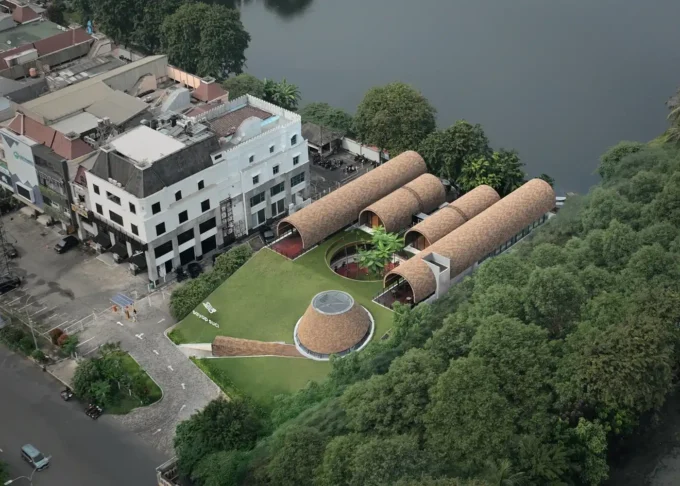Another Smith Restaurant, designed by TasteSpace, is the second-generation venture of Kapor Pla Rim Moei, a renowned Thai-Chinese restaurant in Tak province. The project builds on the legacy of the Smithikorn family, who are celebrated for their signature fish maw dishes. The restaurant’s name, “Another Smith,” references the family surname while highlighting the continuation of their culinary tradition. The design concept draws inspiration from traditional Chinese family seals, employing red as a symbol of good fortune and blue inspired by fish scales, reflecting the secret fish-based recipes that define the family’s culinary identity.
TasteSpace approached the project with a goal to honor heritage while creating a contemporary dining experience, ensuring that the restaurant connects seamlessly with the local context and cultural narrative. Collaboration with bamboo architecture specialists, including Thor Kaichon, emphasized the use of natural, locally sourced materials, promoting sustainability and an intimate connection with the surrounding environment.

Site Planning and Functional Layout
The restaurant is situated on an open plot, allowing for a thoughtfully planned spatial arrangement that supports both operational efficiency and a smooth customer journey. From the Master Plan stage, interior and exterior elements were integrated to create a cohesive flow. The building is organized into three primary zones: a restaurant, a café, and a jewelry shop, each designed to function independently while remaining visually and spatially connected.
The left wing houses the jewelry shop, office, and a private dining room, offering a quieter, exclusive experience. The right wing contains the café and main dining area, designed for casual gatherings and daytime service. The kitchen is centrally located at the rear, allowing staff to serve both the restaurant and private dining areas efficiently. This flexible layout ensures the restaurant can adapt to changing operations—for instance, the café can operate independently in the morning while the main dining area opens later, maintaining a smooth customer experience.

Bamboo as a Core Design Element
A defining feature of Another Smith is its innovative use of bamboo, which informs both the structure and interior aesthetic. To highlight the material’s versatility, TasteSpace and Thor Kaichon developed a custom blue dyeing technique for the bamboo. This is prominently featured in the café ceiling and the building façade, where alternating blue-dyed and natural bamboo creates a fish-scale pattern, referencing the family’s specialty in seafood dishes.
The bamboo not only serves as a structural element but also enhances the sensory experience. Behind the coffee bar, a perforated wall showcasing the “SM” logo becomes a striking visual feature, while the bar counter incorporates blue diagonal tiles echoing the fish-scale motif. These thoughtful interventions create a cohesive visual language that ties together the brand identity and architectural expression.

Interior Design: Harmony of Tradition and Modernity
The interior of Another Smith balances authentic craftsmanship with contemporary comfort. Wood and bamboo dominate the material palette, complemented by soft lighting that accentuates textures and creates a warm, inviting atmosphere. The spatial organization prioritizes both visual and physical accessibility, guiding visitors from the café to the restaurant and private areas with subtle transitions that enhance the dining experience.
Every design decision reflects a desire to immerse visitors in a culturally rich and relaxing environment. The combination of bamboo ceilings, perforated partitions, and fish-scale motifs creates a sense of continuity and identity throughout the space. The interplay of natural materials, light, and color reinforces the restaurant’s Thai-Chinese heritage, offering a modern interpretation without losing connection to tradition.

Brand Identity and Customer Experience
Another Smith is conceived as more than just a restaurant; it is a brand experience. The architectural design communicates the Smithikorn family’s story while providing a flexible space for different types of activities and customer needs. By integrating functional zones, iconic materials, and custom detailing, TasteSpace has created a venue where culinary excellence and architectural storytelling intersect.
Visitors are encouraged to engage with both the food and the space, enjoying the relaxing ambiance while appreciating the visual narrative woven into the bamboo, wood, and color schemes. The result is a distinctive, memorable environment that strengthens brand recognition and loyalty, ensuring that Another Smith stands out as a premier destination in Tak province.

Sustainability and Cultural Sensitivity
The project emphasizes sustainable building practices, particularly through the use of bamboo, a renewable material with minimal environmental impact. By collaborating with local craftsmen and sourcing natural materials, Another Smith not only supports the regional economy but also celebrates traditional Thai-Chinese design methods. This approach ensures the restaurant resonates culturally, environmentally, and socially, establishing it as a model for heritage-sensitive contemporary architecture.
Through a thoughtful balance of heritage inspiration, innovative material use, functional efficiency, and brand storytelling, Another Smith Restaurant represents a successful fusion of culture, design, and dining. It serves as both a culinary destination and a landmark architectural project, reinforcing the identity of the Smithikorn family while engaging visitors in a unique sensory and cultural experience.
Photography: Jinnawat Borihankijanan
- Another Smith Restaurant
- bamboo architecture
- bamboo structural design
- blue-dyed bamboo
- café and restaurant integration
- contemporary dining spaces
- cultural storytelling architecture
- fish-scale motif
- flexible restaurant layout
- Heritage-sensitive design
- modern-traditional fusion
- natural materials interior
- private dining experience
- restaurant brand identity
- sensory design experience
- sustainable restaurant design
- Tak province architecture
- TasteSpace Architects
- Thai-Chinese cuisine design
- Thai-Chinese heritage























































Leave a comment